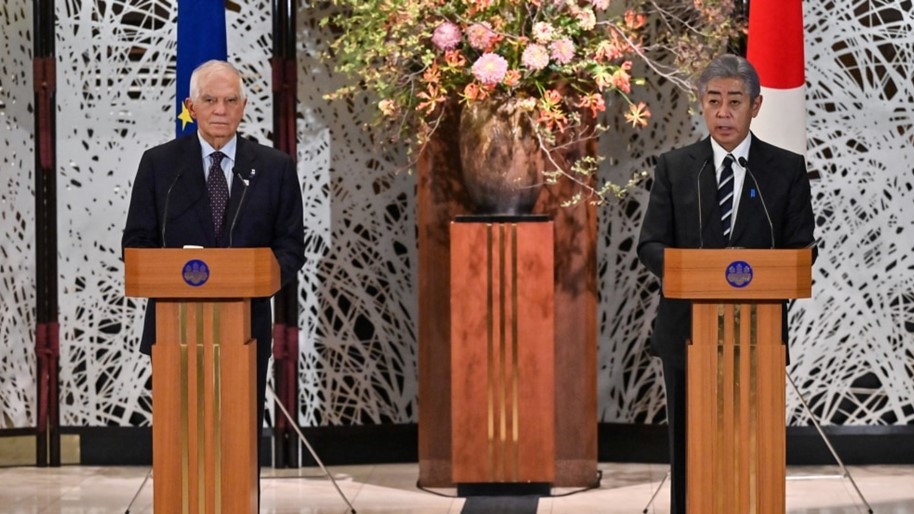The new security pact between the European Union (EU) and Japan indicates a growing role of the combined West in the Asia-Pacific region.

The racketeering at the state level involves powerful states creating threats against weaker states and offering defence pacts – which usually involve sales of expensive weapon systems – to the weaker states for protection from the same threats. Japan’s recent turn towards high defence spending, despite no explicit military threat from China, underscores this racketeering behaviour.
The new EU-Japan Security Pact
As the EU’s foreign policy chief Josep Borrell said, this security pact is the first of its nature that the EU has signed with an Asian Pacific country. Borrel further said that the pact was necessary because “we live in a very dangerous world”. Although Borrel did not mention China, it is quite obvious that the only source of real ‘danger’ in the Asia Pacific region is China, i.e., its massive rise as a global power directly threatening to unseat Western hegemony. The EU’s support also comes against the backdrop of its recent decision to jump on the US-driven bandwagon of a ‘trade war’ with China. In the first week of October, the EU imposed up to 45% tariffs on the import of electric vehicles from China. In doing so, the EU followed the US in its footsteps way more than it seems to have done a rational cost-benefit analysis.
The pact also mimics Washington’s pact with Japan and/or other states in the region. According to the text of the pact, the EU and Japan will promote “concrete naval cooperation”, including through activities such as joint exercises and port calls, which could also include “mutually designated third countries”. It also said the EU and Japan would discuss “the development of respective defence initiatives, including exchange of information on defence industry-related matters”.
There is no denying that this is a crucial development, which will enhance the EU’s role in Asia Pacific affairs. The question, however, is: what explains the timing of this pact?
The EU’s Moves in Anticipation
The EU’s move comes against the backdrop of the return of Donald Trump as the US president. Anticipating his win, reports show that the EU had begun working on the pact a few months ago. Given his actions during the previous presidency where Trump withdrew from multilateral treaties, his next era is expected to feature American (military) disengagement from the region, leaving the space open for other international actors, such as the EU, to capture it. Considering that the EU itself expects America under the Trump administration to disengage from European security, the EU expects multipolarity to grow.
NATO might become increasingly irrelevant, pushing Europe to fend for itself in the global arena. In such a scenario, it makes perfect sense for the EU to make its moves worldwide, including in the Pacific region. Trump’s campaign was loaded with promises of ending wars (and not starting new ones). In that sense, it becomes a golden opportunity for the EU to expand the military aspect of its geopolitical sphere beyond Europe.
Expansion
The EU is already looking at further expansion. For instance, Josep Borrell went to South Korea directly from Japan to discuss North Korea. The visit comes against the backdrop of news reports circulating in the Western media about the possibility of North Korean troops fighting in Ukraine. While we don’t know whether this is true or not and whether the EU is only using this perception to its advantage, there is little denying that the EU is interested in putting its weight behind South Korea for the sake of countering Russian and Chinese support for North Korea. In this way, the EU becomes, alongside the US, a key balancer in the region.
In other words, the introduction of a relatively new military player in the Asia Pacific region means that regional countries will a) be under more Western pressure to enter into new military pacts, and b) they will enter into pacts to counterbalance China. Although China poses no serious threat to the territorial integrity of these countries – the South and East China Seas are territorial disputes of a very limited nature – they still benefit from a diversified pool of military engagement. However, there is a permanent disadvantage that comes with signing military pacts.
These pacts come with no significant opportunities for economic collaboration – something that is more important for states in the region – especially in Southeast Asia – than their disputes with China. If these states can learn from Sino-India border tensions, they recently signed a pact to resolve the dispute – an outcome of extensive diplomatic negotiations, signalling that identical territorial disputes in the South and East China seas are not inherently unmanageable without military means.
Salman Rafi Sheikh, research analyst of International Relations and Pakistan’s foreign and domestic affairs, exclusively for the online magazine “New Eastern Outlook”
